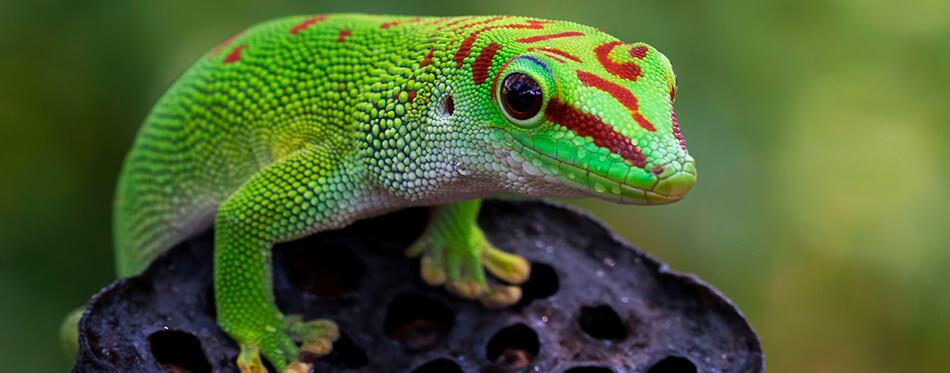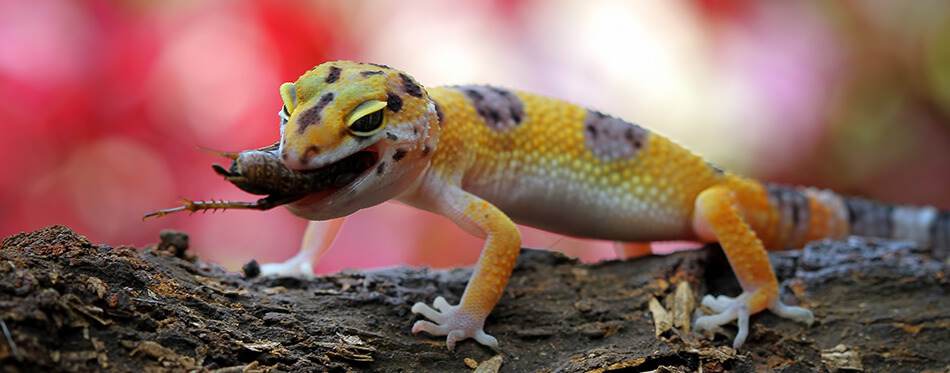Before you bring your pet Gecko home from your local pet store it is vital that you do your research and learn how to look after them correctly. Leopard Geckos have been kept as pets in the US for decades and are the most popular reptile pet here.
They grow to up to 10 inches long and can live for over 20 years if you look after them properly. There are several other types of Geckos that make great pets. But what do Geckos eat? To help you feed your pet geckos the very best diet, we’ve researched everything you need to know about feeding this popular pet and put together a summary of expert opinion.
What do Geckos Eat in the Wild?
In their native environment, Leopard geckos eat pretty much any moving insect that they come across. They are true insectivores. A wild Leopard Gecko will have no interest in vegetables or plants of any kind. They would also not choose to eat insects that are dead – they like live prey.
The timing of food is also important. Wild Leopard Geckos feed during the day and early evening. However, each Gecko is different so you will have to work out what your particular Gecko prefers and feed your Gecko following that feeding schedule. Some are nocturnal and will prefer to be fed at night.

General Advice on Choosing Food for Geckos
There are some general guidelines for feeding most Geckos that will keep them healthy and happy. Here we have collated the top tips from experts.
- Geckos don’t like pre-prepared food. In general, it is best to avoid feeding Leopard Geckos pre-prepared food like kibble. They will not do well on it as dogs and cats do. This means that feeding Geckos is harder work than feeding a cat or dog. You will need to provide live insects by rearing your own crickets, mealworms, or other insects or by purchasing live insects from your local pet store.
- Some Gecko species will eat fruit. Some other species of Geckos eat the fruit in addition to insects. The Crested Geckos and the Day Geckos can eat some fruit. The Leopard Gecko, the House Gecko, the African fat-tailed geckos will only eat insects.
- Feed younger Geckos more often. Young geckos need to be fed every day but adult larger Geckos can be fed every other day.
- Do not feed too many insects at once. When it comes to quantities, they should have as much as they can eat in 20 minutes to prevent overeating. Put one or two insects in your Gecko’s enclosure at a time and stop once they do not seem so enthusiastic.
- Insect size is important. Also, watch out for the size of the insect. If it is bigger than the space between your Gecko’s eyes, your pet will not be able to digest it. Therefore, a baby Leopard Gecko that has just hatched can eat a cricket that is up to 3/8 inch but older baby Geckos (juveniles) could eat one that is about 1/4 inch across. Adult geckos can eat adult crickets.
- Provide constant fresh water. Geckos need constant access to clean water. Misting will also help with humidity.
What do Gecko Lizards Eat?
So, exactly what do Geckos eat? Here are the top four foods that Geckos eat to keep them healthy and happy.
Crickets
These are the most popular insects for a pet Gecko because they are commonly found in pet stores. It is possible to raise insects, especially crickets, yourself at home. You need a clear tote bin with a secure lid with holes for ventilation, a three-inch depth of vermiculite at the bottom, and a small plastic container full of very wet and loose soil. And, of course, a selection of male and female crickets. You also need to supply plenty of fresh water and an incubator to maintain the correct temperature as crickets live in warm climates.
Mealworms
As their name suggests, mealworms look like small worms. They are full of protein and are very healthy food for most Geckos. However, mealworms are quite large which means that they would suit a Leopard Gecko but may be too big for baby Geckos and House Geckos to digest. It is quite easy to raise your own mealworms using a large circular biscuit tin with holes punched in the top for ventilation and a substrate of bran.
Waxworms and Superworms
These are very rich in fat compared to other insects and should only be fed to Geckos once a week. A waxworm contains 22.19% fat and a superworm contains 17.89% fat compared to cricket which is only 6% fat. These fatty insects should only be given as a treat.
Flies
Most pet Geckos will happily eat several different types of flies. However, fruit flies are the most common as they are most readily available online and in pet stores.
Pinky mice
Pinky mice are one to two-day-old mice that you can buy from pet shops to feed to captive reptiles. They can be purchased live or frozen. There is some debate amongst experts about whether adult Geckos can eat pinky mice. On the whole, they are thought to be suitable as many Geckos in the wild would eat small rodents such as a baby mouse. Pinky mice provide valuable vitamins and minerals into your Gecko’s diet that you would otherwise have to provide with supplements such as calcium powder to prevent metabolic bone disease. They should not make up the main diet and are best fed as an occasional treat.
Fruit
Crested Geckos and the other Gecko species that can eat fruit (frugivorous) can be fed fruit such as apples and grapes. The fruit needs to be chopped into pieces that are smaller than the space between the Gecko’s eyes. A top tip for new owners is to purchase a pre-prepared Gecko fruit mix that will be nutritionally balanced for your pet.
Powdered Gecko Food
The Crested Gecko can eat special powdered Crested Gecko food and the Day Gecko can eat a Gecko diet mix. The Leopard Gecko, however, should only have insects.
Top Tips on Insects for Geckos
Whilst insects form the basis of a healthy diet for most Geckos, there are a few things that you should bear in mind.
- Do not feed wild caught insects. It is not a good idea to feed wild caught insects as they could contain harmful chemicals or parasites. Also, some could be toxic for Geckos.
- Maintain a varied diet. Once you get your Leopard Gecko eating regularly it is tempting to stick to the same diet. However, they can change their food preferences from day to day and a combination of different insects with different nutritional profiles will ensure that they have a balanced diet.
- Do not feed glowing insects. The chemical that causes fluorescence in insects is highly toxic to Geckos
- Gut load crickets. Make sure that the crickets are well fed with nutritious food (this is called gut loading) so that they provide your Gecko with plenty of nutrients.
How to Feed Your Gecko
You could place the insects in a small dish but other Geckos prefer to eat insects from long tweezers. This gives you more control and you can closely monitor how much they are eating.
Uneaten food (insects and fruit) must always be cleared away from inside the Gecko’s tank. Both can rot and can create an unhealthy environment for your pet.

Feeding Geckos in Summary
There are different species of pet Gecko. Some will only eat insects but others will eat a combination of fruit and insects. Crickets are the most popular gecko food and you can buy these alive or you can raise your own which is more work but is cheaper. Other insects can be given as a treat. Do not feed Geckos glowing insects or wild-caught insects.
Feed your Gecko until they stop showing an interest in the food and always clear away leftovers. Make sure that they always have a constant supply of clean and fresh water. If you have any concerns, seek veterinary advice from a reptiles expert.
Sources:
- Leopard Gecko – RSCPA
- Leopard Gecko – Eublepharis macularius – Pet MD

